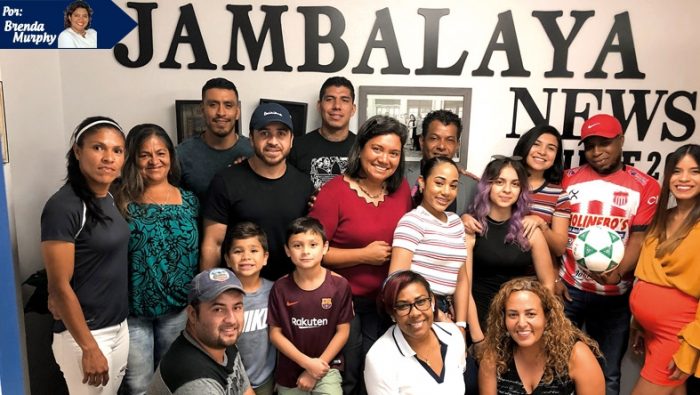
Jambalaya News is one of those organizations that’s hard to pin down — because it’s busy doing as much as it can for its ever-growing community.
I first met publisher and editor Brenda Murphy and COO Rocio Tirado in the organization’s hometown of New Orleans during ONA (credit to Daniela Gerson, senior fellow at the Center for Community and Ethnic Media at the CUNY Newmark Graduate School of Journalism who is working on a study of media outlets serving immigrant communities). We were only a few months past the merger of the city’s two main newspapers and the layoff of nearly the entire Times-Picayune newsroom; 14 years past Hurricane Katrina and its reshaping of every aspect of the city; 15 years and two months past Murphy launching Jambalaya News as a Spanish-language newspaper with a sports focus.
Now, in addition to its reporting focused on the city’s Latino community, Jambalaya News has organized a soccer league, job fairs, radio shows (also aired on Facebook Live and TuneIn), multiple print publications, and more. In a call after Murphy’s morning radio show a few weeks later, I asked the two women to define Jambalaya News in their own words to me.
“It’s the community. It’s not a newspaper, not a soccer league, not an academy for kids’ soccer, not a radio station,” said Murphy. “The community is growing faster than we can imagine. People need a voice. I’m a journalist — this is my career, my profession. But when I see the necessity for a media outlet that can be a voice for the community, I see the opportunity, and we established [the outlet] because we are the community.”
Murphy started publishing Jambalaya News in July 2004, a little more than a year before Katrina. The organization was originally focused on sports, but after the hurricane hit its mission was reshaped as well. “Right after Katrina, there wasn’t sports to cover. The disaster was so big…all the spaces were used for the point of help for people,” Tirado, who joined the organization 13 years ago, said.
Now, she said, “I believe Jambalaya News is the bridge for the community. Many of the events we do are for people to get engaged with what we do. When they look for the news when they need a trusted source, they’ll think about Jambalaya News.”
The flooding after Katrina drove hundreds of thousands of residents away from New Orleans, cutting the city’s population by more than half — from an estimated 454,000 residents in 2005 to 208,000 a year later. With a huge demand for construction workers and others to rebuild the city, as many as 100,000 Latino immigrant workers came to New Orleans in the first few months after Katrina; the 2010 census noted an increase of 57 percent in the metro area’s Latino population over 2000. The Times-Picayune noted in 2015 that “while the population of the region as a whole remains at about 80 percent of pre-Katrina levels, the Latino population has nearly doubled since the storm.”
In that context, Murphy pivoted Jambalaya News and began holding job fairs and coordinating other community events. “When we see a need, we are able to get volunteers. We organize and make it happen, so people feel like they are closer to us,” Tirado said.
In the decade-plus since, Murphy and Tirado have built Jambalaya News into a piece of the community. For Murphy and Tirado, that’s their neighbors, friends, and readers/listeners/viewers. They still cover sports, but also hurricane threats in Mexico, deportations from the U.S., Hong Kong protests, drug trafficking and crime, and, of course, more on sports:
Social media, unsurprisingly, helps Jambalaya News stay in touch with its community, in addition to the 17,000 copies of its now-monthly newspaper and its website. When the outlet had to switch from a terrestrial radio station to online broadcasting a few years ago (a contract for the studio space wasn’t renewed), they turned to Facebook Live to cross-air the show and remind people that they could find it on TuneIn, the radio app popular in Latin America. “The Central American people are using the TuneIn app to listen to radio stations from their countries, so it’s nothing new,” Murphy said. “But with Facebook, you can say to the Central American people, ‘We are here.'”
Jambalaya News mainly relies on advertising for income, though Tirado said it’s becoming increasingly challenging to convince people that (a) print advertising is not yet dead and/or (b) digital advertising is not too newfangled for them to try. The two women are the outlet’s full-time staff, working with a range of part-time helpers and freelancers who help them cover the 14 parishes around New Orleans and pull off its radio shows and local events.
“Something we could help our community with a lot is educating people,” Tirado said, talking about the relative newcomers to the New Orleans area. “As media, we have the responsibility to help and teach our community where they’re living and what are the laws and rules to be good citizens.”
“If we grow with the job we do right now, we can connect more with the community,” Murphy said. “We need more equipment. We need a lot of things. [But] we go step by step. At this point, we do a lot of things, but we need more help.”